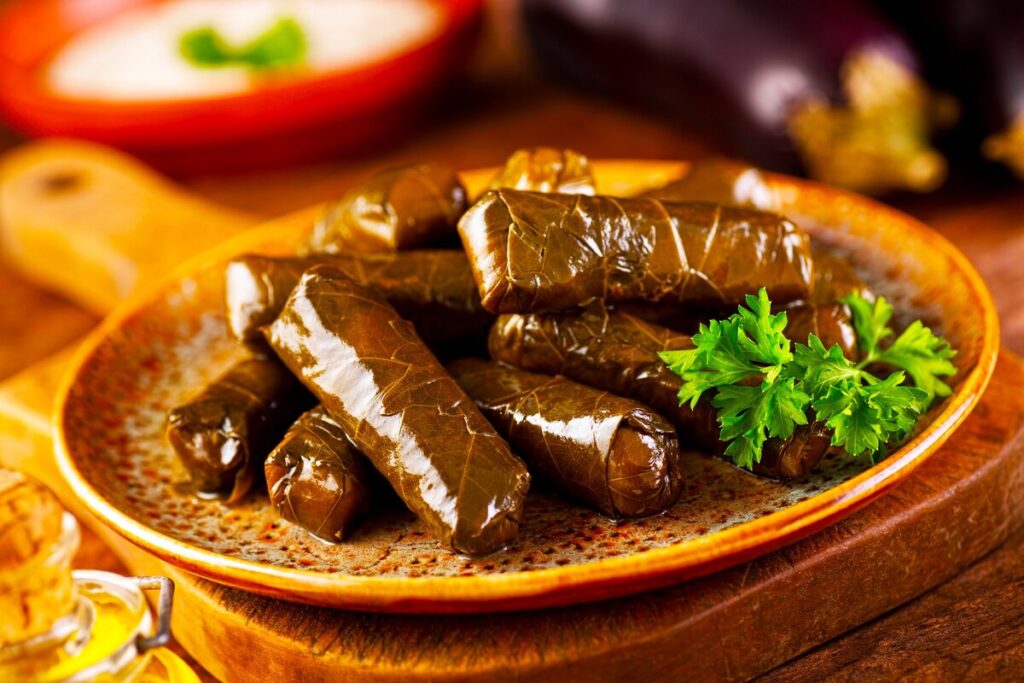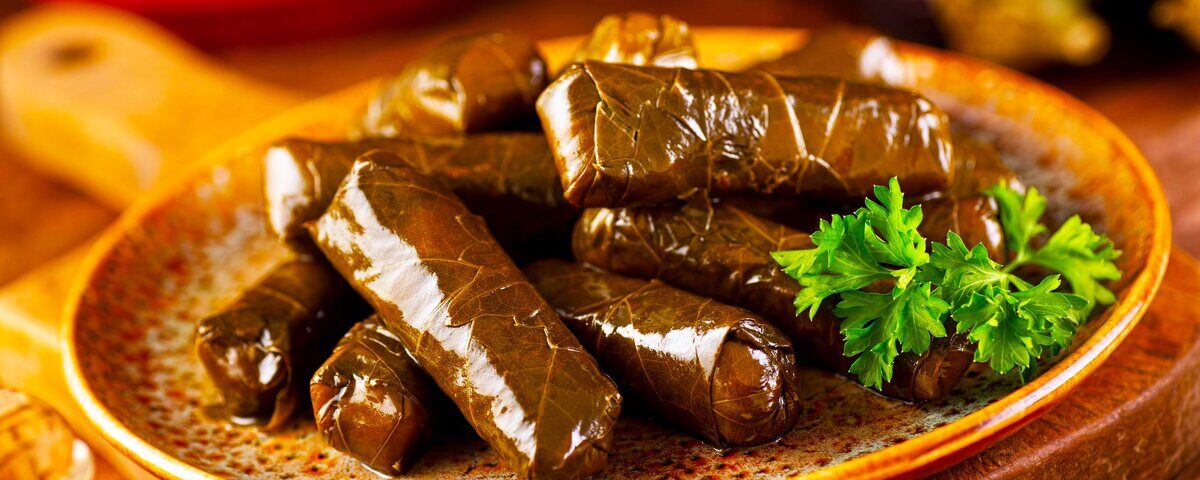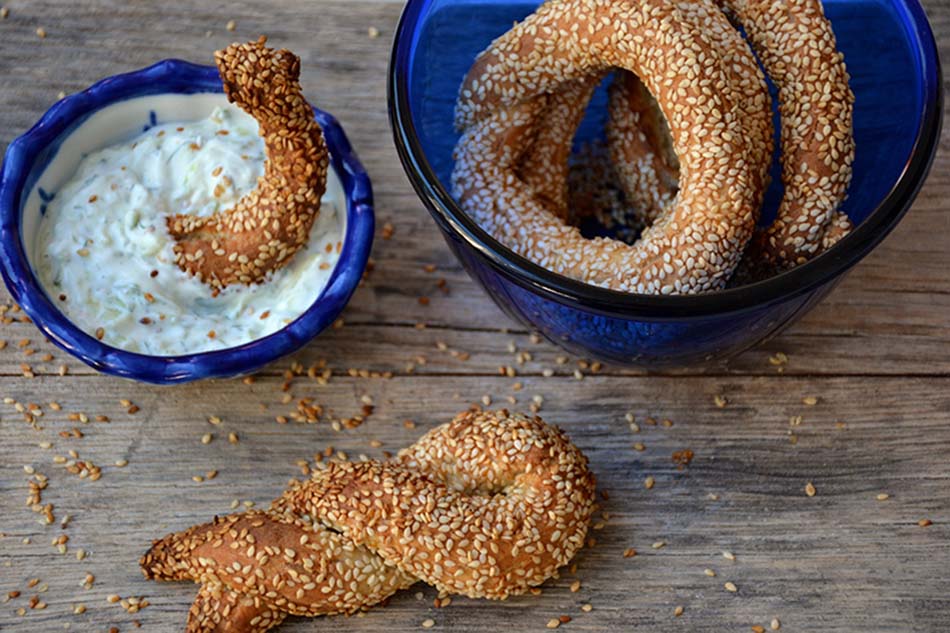
The Delicious World of Baklava: A Sweet Journey Through History, Ingredients, and Recipes

The Ultimate Guide to Greek Salad
The Ultimate Guide to Dolmades
What Are Dolmades?
Dolmades are delectable, bite-sized morsels that boast an intricate blend of flavors. These grape leaf-wrapped parcels are traditionally filled with a savory mix of rice, herbs, and sometimes minced meat. They are a staple in Mediterranean cuisine, with roots tracing back to Greek and Turkish culinary traditions. As you explore the world of dolmades, you’ll find that each region has its unique spin on this classic dish. Whether you’re a seasoned foodie or a culinary novice, dolmades offer a flavorful journey you won’t want to miss.

History of Dolmades
Dolmades have a storied history that reflects the cultural tapestry of the Mediterranean region. The term “dolma” is derived from the Turkish word “dolmak,” which means “to fill.” These stuffed grape leaves have been enjoyed for centuries, with references to similar dishes appearing in ancient texts.
Ancient Beginnings
Grape leaves were valued in ancient Greece and Rome for their medicinal and culinary uses. In these early civilizations, grape leaves were often stuffed with rice, nuts, and herbs. As the Mediterranean region experienced waves of migration and conquests, the recipes evolved, incorporating spices and ingredients from various cultures.
Ottoman Influence
The Ottoman Empire had a significant impact on the cuisine of the regions it encompassed. The Ottomans refined the dolma, adding meat to the stuffing and experimenting with different types of leaves and vegetables. The dish became popular across the empire, from the Balkans to the Middle East.
Types of Dolmades
While grape leaves are the most traditional wrapping for dolmades, other variants exist that use different leaves or vegetables. Here are a few popular types:
Grape Leaf Dolmades
These are the most widely known and classic version of dolmades. The filling typically consists of rice, pine nuts, onions, fresh herbs like dill and mint, and occasionally minced meat. They can be served hot or cold, often accompanied by a tangy lemon sauce or yogurt.
Cabbage Dolmades
In this variation, cabbage leaves replace grape leaves. This type of dolma is especially popular in Balkan countries. The filling is similar but may include sauerkraut and paprika, giving it a unique flavor profile.
Vine Vegetables
Another delightful variation involves stuffing vegetables like bell peppers, zucchini, or tomatoes. These stuffed vegetables are often baked in a tomato-based sauce, enriching the dish’s flavors.
Ingredients for Dolmades
Crafting the perfect dolmades requires a delicate balance of ingredients. Here’s a list of what you’ll need:
- Grape Leaves: Fresh or jarred grape leaves. If using jarred, rinse thoroughly to remove excess brine.
- Rice: Short-grain rice is preferred for its stickiness, which helps bind the filling.
- Meat (optional): Ground beef or lamb can be added for a heartier dish.
- Onions: Finely chopped onions add a sweet and savory flavor.
- Pine Nuts: Provide a subtle, nutty crunch.
- Raisins or Currants: Add a touch of sweetness.
- Fresh Herbs: Dill, mint, and parsley are essential for a vibrant taste.
- Olive Oil: A good quality extra virgin olive oil adds richness.
- Lemon Juice: For a tangy, acidic balance.
- Salt and Pepper: To season to taste.
How to Make Dolmades
Making dolmades at home might seem daunting, but the process is straightforward with a little patience. Here’s a step-by-step guide:
Preparation
- Prepare the Grape Leaves: If using fresh grape leaves, blanch them in boiling water for a couple of minutes until soft. If using jarred, rinse them well.
- Cook the Rice: Rinse the rice and cook it halfway through. It will finish cooking inside the grape leaves.
- Sauté the Onions: In a pan, heat some olive oil and sauté the onions until translucent. Add pine nuts, raisins, and the partially cooked rice. Mix well.
Assembling Dolmades
- Prepare the Filling: Add chopped herbs, salt, and pepper to the rice mixture. Mix thoroughly.
- Stuff the Leaves: Lay a grape leaf flat, shiny side down. Place a teaspoon of filling near the stem end. Fold the stem end over the filling, tuck in the sides, and roll up tightly.
- Arrange in a Pot: Place the dolmades seam-side down in a pot. Pack them tightly to prevent unrolling during cooking.
Cooking Dolmades
- Add Lemon and Water: Pour lemon juice and enough water or broth to just cover the dolmades.
- Cover and Cook: Place a heatproof plate on top of the dolmades to keep them submerged. Cover the pot and simmer on low heat for about 45 minutes to an hour.
- Rest and Serve: Allow the dolmades to cool slightly before serving them with additional lemon wedges and a drizzle of olive oil.
Serving Suggestions
Dolmades are versatile and can be served as an appetizer, side dish, or main course. Here are some serving ideas:
With Yogurt Sauce
Serve dolmades with a simple yogurt sauce made by mixing Greek yogurt, minced garlic, chopped dill, and a splash of lemon juice.
As a Mezze Platter
Include dolmades in a mezze platter alongside hummus, tzatziki, olives, feta cheese, and pita bread for a delightful and diverse spread.
Warm with Tomato Sauce
For a comforting meal, warm dolmades in a tomato-based sauce and serve with a side of crusty bread.
Nutritional Benefits
Dolmades are not only delicious but also pack a nutritional punch. They are rich in vitamins and minerals, thanks to the grape leaves and fresh herbs. The addition of olive oil provides healthy fats, while rice and pine nuts offer energy-boosting carbohydrates and proteins. If you opt for a meat-filled version, you’ll also get a good dose of iron and other essential nutrients.
Tips for Perfect Dolmades
- Do Not Overfill: Rice expands as it cooks, so avoid overfilling the grape leaves.
- Use Fresh Herbs: Fresh herbs impart a much stronger flavor than dried ones.
- Seal Tightly: Ensure the dolmades are tightly packed in the pot to prevent unrolling.
- Cook Slowly: Slow cooking allows the flavors to develop fully.
Conclusion
Dolmades are a timeless dish that brings a taste of Mediterranean history and culinary excellence to your table. Whether you stick to the traditional grape leaf version or explore other variations, making dolmades is a rewarding culinary endeavor. With a rich blend of flavors and textures, these stuffed grape leaves are sure to impress at any meal. So why not give them a try and enjoy a little piece of Mediterranean heritage?
By incorporating these elements into your dolmades-making journey, you’ll not only master a classic dish but also embrace a rich culinary tradition. Enjoy the process, and savor every bite!



3 Comments
[…] So why wait? Gather those eggplants, fire up the oven, and embark on a flavorful journey that will transport you straight to the sun-drenched shores of Greece. Enjoy!The Ultimate Guide to Dolmades […]
[…] The Ultimate Guide to Dolmades […]
[…] The Ultimate Guide to Dolmades […]